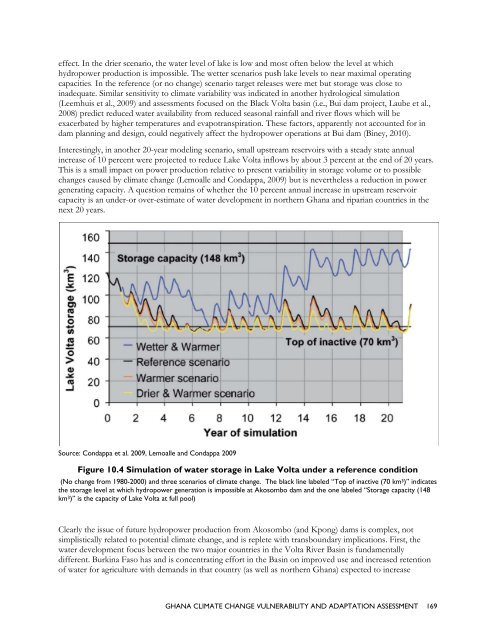ghana climate change vulnerability and adaptation assessment
ghana climate change vulnerability and adaptation assessment
ghana climate change vulnerability and adaptation assessment
- No tags were found...
You also want an ePaper? Increase the reach of your titles
YUMPU automatically turns print PDFs into web optimized ePapers that Google loves.
effect. In the drier scenario, the waterlevel of lake is low <strong>and</strong> most often below the level atwhichhydropower productionis impossible. The wetter scenarios pushh lake levels tonear maximal operatingcapacities. In the reference (or no <strong>change</strong>) scenariotarget releases were met but storage was close toinadequate. Similar sensitivity to <strong>climate</strong> variability was indicatedd in another hydrological simulation(Leemhuiset al., 2009) <strong>and</strong> <strong>assessment</strong>s focused onthe Black Volta basin (i.e., Bui dam project, Laube et al.,2008) predict reduced water availability from reduced seasonal rainfall <strong>and</strong> river flows which will beexacerbated by higher temperatures <strong>and</strong> evapotranspiration. These factors, apparently not accounted forindam planning <strong>and</strong> design, could negatively affect the hydropower operations at Bui dam (Biney, 2010).Interestingly, in another20-year modeling scenario, small upstream reservoirss with a steadystate annualincrease of 10 percent were projectedto reduce Lake Volta inflows by about 3 percent at the end of 20 years.This is a small impact on power production relative to present variability in storage volumeor to possible<strong>change</strong>s caused by <strong>climate</strong> <strong>change</strong> (Lemoalle <strong>and</strong> Condappa, 2009) but is nevertheless a reduction in powergeneratingg capacity. A question remains of whether the 10 percent annual increase in upstream reservoirrcapacity isan under-or over-estimateof water development in northern Ghana <strong>and</strong> ripariancountries in thenext 20 years.Source: Condappa et al. 2009, Lemoalle <strong>and</strong>Condappa 2009Figure 10.4 Simulation of water storage in Lake Volta undera reference conditionn(No <strong>change</strong>from 1980-2000) <strong>and</strong> three scenarios of <strong>climate</strong> <strong>change</strong>. The black line labeled “Top of inactive (70 km 3 )” indicatesthe storage level at which hydropower generation is impossible at Akosombo dam <strong>and</strong> thee one labeled “Storage capacity (148km 3 )” is thecapacity of Lake Volta at full pool)Clearly theissue of future hydropower production from Akosombo (<strong>and</strong> Kpong) dams is complex, notsimplistically related to potential <strong>climate</strong> <strong>change</strong>, <strong>and</strong> is replete with transboundary implications. First, thewater development focus between the two major countries in the Volta Riverr Basin is fundamentallydifferent. Burkina Faso has <strong>and</strong> is concentrating effort in the Basin on improved use <strong>and</strong> increased retentionof water for agriculture with dem<strong>and</strong>s in that country (as well ass northern Ghana) expectedto increaseGHANA CLIMATE CHANGE VULNERABILITY ANDADAPTATIONASSESSMENT169
















